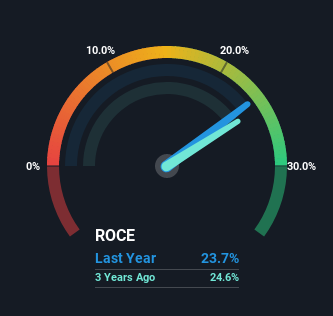- India
- /
- Electrical
- /
- NSEI:PITTIENG
Returns On Capital Are A Standout For Pitti Engineering (NSE:PITTIENG)
What are the early trends we should look for to identify a stock that could multiply in value over the long term? Typically, we'll want to notice a trend of growing return on capital employed (ROCE) and alongside that, an expanding base of capital employed. If you see this, it typically means it's a company with a great business model and plenty of profitable reinvestment opportunities. So when we looked at the ROCE trend of Pitti Engineering (NSE:PITTIENG) we really liked what we saw.
What is Return On Capital Employed (ROCE)?
Just to clarify if you're unsure, ROCE is a metric for evaluating how much pre-tax income (in percentage terms) a company earns on the capital invested in its business. To calculate this metric for Pitti Engineering, this is the formula:
Return on Capital Employed = Earnings Before Interest and Tax (EBIT) ÷ (Total Assets - Current Liabilities)
0.24 = ₹1.1b ÷ (₹9.6b - ₹4.9b) (Based on the trailing twelve months to March 2022).
Thus, Pitti Engineering has an ROCE of 24%. In absolute terms that's a great return and it's even better than the Electrical industry average of 12%.
Check out our latest analysis for Pitti Engineering

Historical performance is a great place to start when researching a stock so above you can see the gauge for Pitti Engineering's ROCE against it's prior returns. If you're interested in investigating Pitti Engineering's past further, check out this free graph of past earnings, revenue and cash flow.
How Are Returns Trending?
Pitti Engineering is displaying some positive trends. The data shows that returns on capital have increased substantially over the last five years to 24%. The amount of capital employed has increased too, by 164%. This can indicate that there's plenty of opportunities to invest capital internally and at ever higher rates, a combination that's common among multi-baggers.
On a separate but related note, it's important to know that Pitti Engineering has a current liabilities to total assets ratio of 51%, which we'd consider pretty high. This can bring about some risks because the company is basically operating with a rather large reliance on its suppliers or other sorts of short-term creditors. While it's not necessarily a bad thing, it can be beneficial if this ratio is lower.
The Bottom Line
All in all, it's terrific to see that Pitti Engineering is reaping the rewards from prior investments and is growing its capital base. And with the stock having performed exceptionally well over the last five years, these patterns are being accounted for by investors. Therefore, we think it would be worth your time to check if these trends are going to continue.
One more thing: We've identified 2 warning signs with Pitti Engineering (at least 1 which is potentially serious) , and understanding them would certainly be useful.
If you want to search for more stocks that have been earning high returns, check out this free list of stocks with solid balance sheets that are also earning high returns on equity.
New: Manage All Your Stock Portfolios in One Place
We've created the ultimate portfolio companion for stock investors, and it's free.
• Connect an unlimited number of Portfolios and see your total in one currency
• Be alerted to new Warning Signs or Risks via email or mobile
• Track the Fair Value of your stocks
Have feedback on this article? Concerned about the content? Get in touch with us directly. Alternatively, email editorial-team (at) simplywallst.com.
This article by Simply Wall St is general in nature. We provide commentary based on historical data and analyst forecasts only using an unbiased methodology and our articles are not intended to be financial advice. It does not constitute a recommendation to buy or sell any stock, and does not take account of your objectives, or your financial situation. We aim to bring you long-term focused analysis driven by fundamental data. Note that our analysis may not factor in the latest price-sensitive company announcements or qualitative material. Simply Wall St has no position in any stocks mentioned.
About NSEI:PITTIENG
Pitti Engineering
Manufactures and sells iron and steel engineering products in India and internationally.
Excellent balance sheet with reasonable growth potential.
Market Insights
Community Narratives





